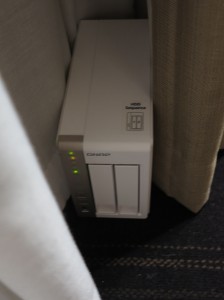How can Starlink improve their end-user equipment?
As I see Starlink build up its low-earth-orbit satellite Internet service, I would need to see them provide services that can answer particular user needs better.
But I would see Starlink offer these kinds of improvements as they refresh their consumer equipment or whenever there is competition afoot. This could be in the form of Amazon’s Project Kuiper constellation or the OneWeb constellation that will be offered through a variety of telcos and ISPs.
A satellite terminal that provides a WAN connection to the customer
At the moment, the Starlink terminals offered in the retail marketplace have a built-in Wi-Fi-only router. But I would like to see them offer terminals with a “WAN-level” Ethernet output that allows the terminal to work with an external broadband router.
This may suit a range of consumers who need a better router than what Starlink builds in to their own terminals. Firstly, there are business users who would prefer to use business-grade equipment that offers what they need for their Internet connection such as VPN endpoint functionality or business-grade Wi-Fi segments that implement “enterprise-level” features. It can also encompass the use of routers that are optimised for offering public-access Internet service or even the use of high-performance routers for activities like online games.
There is an increasing range of multi-WAN routers that have two or more WAN / Internet sources, whether that be through an integrated modem like a cellular modem or an Ethernet connection. These arrangements would come in to their own for fail-safe Internet connections or to provide load-balancing or increased throughput (“fat-pipe” operation) for the Internet connection.
Add to this the use of distributed Wi-Fi systems that have one of the modules working as a router while the other devices work akin to an access point. This would come in to its own with larger rural and remote properties where there is a desire to assure property-wide Internet and home-network access. Various standards like Wi-Fi EasyMesh and some newer Wi-Fi variants pitched for long-distance networks could lead to innovation when it comes to rural-property Wi-Fi coverage.
This could be facilitated with a modem-router satellite terminal that has at least one Ethernet port and supports a “modem” or similar operating mode. Such a mode would then support the use of an external router.
At least one Ethernet LAN connection on modem-router satellite terminals

Having Ethernet on Starlink satellite terminals could allow them to work with NAS storage devices and similar devices
There are uses who would rather benefit from having a wired LAN segment as part of our home networks. This would require at least one Ethernet LAN port on the router. Some of the use cases would include NAS devices, smart TVs, desktop computers and the like or creating a multi-building home network which may appeal to a lot of farmers with barns and the like.
The pleasure-boat user class could also benefit from Ethernet LAN connectivity especially where there are marine electronics devices that handle large amounts of data like marine radar or electronic mapping systems. I would also extend to this network-connected AV equipment used on board a cabin cruiser, narrowboat or similar vessel where such vessels have at least one living area like a saloon where a TV with online-video services may be installed. Here, this user class can then benefit from a vessel-wide Ethernet network segment that answers all of these needs.
This user class could be served by either a satellite terminal that provides a WAN-level Internet connection that is used with a broadband router that has at least one Ethernet LAN port. Or a satellite terminal that provides at least Ethernet LAN connection in addition to Wi-Fi as has been done with most modem-router products.
Factoring in mariners who only do limited sailing

Starlink could offer better tariffs for people who use boats on inland waterways, on neighbouring islands or on their continent’s coast.
There are a significant number of mariners who sail only within inland waterways like lakes and rivers or sail along a small portion of their home continent’s coastline such as within a bay or estuary. It may also extend to people who sail a short distance between islands or from a continent to its neighbouring islands.
At the moment, such mariners who want to benefit from Starlink are asked to pay dearly for their service because it is assumed they intend to go to the oceans. This is even if they are just after a water-resistant marine-friendly modem for their craft while working within the inland waters or similar areas.
What could be looked at is a reasonably-priced service price tier for Starlink services used on small pleasure craft working within certain waterway classes like inland waterways, bays and estuaries, archipelagos of islands or close to the coastline. This factors in most pleasure-craft users who own reasonably-priced vessels with limited navigation abilities rather than those using more expensive craft like superyachts that have wider navigation abilities. As well, it could be about small-time fishing boats, scientific-research craft and the like being able to benefit from Starlink satellite broadband Internet. It could even factor in those of us who keep these boats tied up at a marina as a “holiday house” but take them out on the water on occasions.
Conclusion
These kind of options could come about as an increase in competition starts to exist between low-earth-orbit satellite operators. Here, it would manifest in a variety of hardware for these systems or an increase in the number of reasonably-priced consumer tariffs for these services.
They could also make satellite Internet appeal to an increased range of users who exist in regional, rural and remote areas including the waters.





![German countryside - By Manfred&Barbara Aulbach (Own work) [CC-BY-SA-3.0 (http://creativecommons.org/licenses/by-sa/3.0) or GFDL (http://www.gnu.org/copyleft/fdl.html)], via Wikimedia Commons](https://homenetworking01.info/wp-content/uploads/2014/08/Feldweg_in_der_Nähe_von_Diemelstadt-300x199.jpg)
![Yorkshire Dales By Kreuzschnabel (Own work) [CC-BY-SA-3.0 (http://creativecommons.org/licenses/by-sa/3.0), GFDL (http://www.gnu.org/copyleft/fdl.html) or FAL], via Wikimedia Commons](https://homenetworking01.info/wp-content/uploads/2014/09/2013_Langthwaite_Arkengarthdale-Yorkshire-Dales-300x225.jpg)